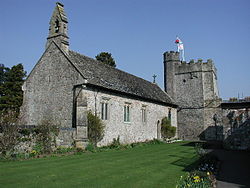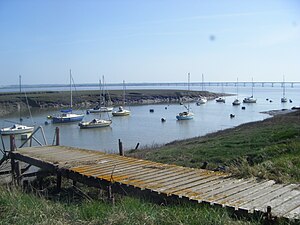Difference between revisions of "St Pierre"
m (Owain moved page St Pierre, Monmouthshire to St Pierre) |
m (→History) |
||
| Line 18: | Line 18: | ||
==History== | ==History== | ||
| − | The manor of St Pierre was originally part of the parish of Runston, now a deserted village, and was later amalgamated for civil purposes with the neighbouring parish of Mathern. It is uncertain whether the name originates from a Welsh family, Pŷr, or is of Norman origin. | + | The manor of St Pierre was originally part of the parish of [[Runston]], now a deserted village, and was later amalgamated for civil purposes with the neighbouring parish of [[Mathern]]. It is uncertain whether the name originates from a Welsh family, Pŷr, or is of Norman origin. |
[[File:Inside St Pierre Church - geograph.org.uk - 486472.jpg|thumb|right|Inside St Peter's Church]] | [[File:Inside St Pierre Church - geograph.org.uk - 486472.jpg|thumb|right|Inside St Peter's Church]] | ||
Around 1380, St Pierre was owned by Sir David ap Philip, who served under King Henry V in France, and the name of his son, Lewis, was later adopted by his family and descendants as their surname. The manor continued to be held by the Lewis family until about 1910. Thomas Lewis, Esq., married the daughter of Sir Richard Levett, Lord Mayor of London, and other Lewis family members also made propitious marriages. Several members of the family became High Sheriffs of Monmouthshire.<ref name=bradney>Sir Joseph Bradney, ''A History of Monmouthshire'', 1904–33</ref> Others became Members of Parliament, including Thomas Lewis who was MP for [[Monmouth]], [[Newport, Monmouthshire|Newport]] and [[Usk]] between 1713 and 1752. His family took over and developed the "New Passage" ferry service across the Severn from [[Portskewett#Black Rock|Black Rock]], in competition with the "Old Passage" service run from Beachley by the Duke of Beaufort.<ref>Ivor Waters, ''Turnpike Roads - the Chepstow and New Passage Turnpike Districts'', 1985, ISBN 0-906134-31-5</ref> In 1925, the mansion and deer park were sold to Daniel Lysaght.<ref>[http://www.archivesnetworkwales.info/cgi-bin/anw/search2?coll_id=1187&inst_id=36&term= Archives Network - St. Pierre estate records]</ref> | Around 1380, St Pierre was owned by Sir David ap Philip, who served under King Henry V in France, and the name of his son, Lewis, was later adopted by his family and descendants as their surname. The manor continued to be held by the Lewis family until about 1910. Thomas Lewis, Esq., married the daughter of Sir Richard Levett, Lord Mayor of London, and other Lewis family members also made propitious marriages. Several members of the family became High Sheriffs of Monmouthshire.<ref name=bradney>Sir Joseph Bradney, ''A History of Monmouthshire'', 1904–33</ref> Others became Members of Parliament, including Thomas Lewis who was MP for [[Monmouth]], [[Newport, Monmouthshire|Newport]] and [[Usk]] between 1713 and 1752. His family took over and developed the "New Passage" ferry service across the Severn from [[Portskewett#Black Rock|Black Rock]], in competition with the "Old Passage" service run from Beachley by the Duke of Beaufort.<ref>Ivor Waters, ''Turnpike Roads - the Chepstow and New Passage Turnpike Districts'', 1985, ISBN 0-906134-31-5</ref> In 1925, the mansion and deer park were sold to Daniel Lysaght.<ref>[http://www.archivesnetworkwales.info/cgi-bin/anw/search2?coll_id=1187&inst_id=36&term= Archives Network - St. Pierre estate records]</ref> | ||
Latest revision as of 22:02, 3 December 2019
| St Pierre | |
| Monmouthshire | |
|---|---|
 The Church of St Peter, adjoining the hotel and golf course | |
| Location | |
| Grid reference: | ST515905 |
| Location: | 51°36’42"N, 2°42’9"W |
| Data | |
| Population: | 144 |
| Post town: | Chepstow |
| Postcode: | NP16 |
| Dialling code: | 01291 |
| Local Government | |
| Council: | Monmouthshire |
| Parliamentary constituency: |
Monmouth |
St Pierre is an ancient parish and hamlet in Monmouthshire, three miles south-west of Chepstow and adjacent to the Severn estuary. It is now the site of a large golf and country club, the Marriott St Pierre Hotel & Country Club, which was previously a large manor house and deer park belonging to the Lewis family.
History
The manor of St Pierre was originally part of the parish of Runston, now a deserted village, and was later amalgamated for civil purposes with the neighbouring parish of Mathern. It is uncertain whether the name originates from a Welsh family, Pŷr, or is of Norman origin.
Around 1380, St Pierre was owned by Sir David ap Philip, who served under King Henry V in France, and the name of his son, Lewis, was later adopted by his family and descendants as their surname. The manor continued to be held by the Lewis family until about 1910. Thomas Lewis, Esq., married the daughter of Sir Richard Levett, Lord Mayor of London, and other Lewis family members also made propitious marriages. Several members of the family became High Sheriffs of Monmouthshire.[1] Others became Members of Parliament, including Thomas Lewis who was MP for Monmouth, Newport and Usk between 1713 and 1752. His family took over and developed the "New Passage" ferry service across the Severn from Black Rock, in competition with the "Old Passage" service run from Beachley by the Duke of Beaufort.[2] In 1925, the mansion and deer park were sold to Daniel Lysaght.[3]
It was thought that the family had ended with the death of Thomas Lewis. Direct decedents, however, still survive and thrive. Given the recorded history of the family lineage this makes it one of the oldest families in the United Kingdom. The Lewis family still retain their surname and family crest, usually worn as a signet ring depicting a griffin. The family continues to grow though they no longer live in the locality, but instead across the country from Cheshire to Brighton, occupying positions in the city and the legal profession.
The church of St Peter has a Norman doorway and windows, but was largely rebuilt in later centuries. In the chancel are two ancient slabs bearing an inscription in Norman French to Urien de St Pierre, lord of the manor who died in 1239.[4] There are also numerous monuments to members of the Lewis family.[5]
The former manor house includes a 16th-century gatehouse, but the remainder of the building was largely built in the 19th century. Major extensions have been added since the house became a hotel in the 1960s. It was bought by Tintern Abbey Hotels in 1961, and a golf course (now "the Old Course") was opened in 1962 with a second course in 1975.[6]
Golf club
St Pierre Golf & Country Club was the venue for the Curtis Cup in 1980, the Solheim Cup in 1996, and the PGA Welsh Masters in 2000. The club has also hosted many European Tour events including the Epson Grand Prix of Europe from 1986 to 1991 (match play until 1989 and then stroke play), and the British Masters on eight occasions between 1971 and 1983. The Old Course boasts a championship length of over 6,000 yards, par 72.[6] It hosted the 2010 Fightmaster Cup.
St Pierre Pill
St Pierre Pill, one mile south of the golf club, is an anchorage for small boats on the Severn estuary. It is the base of the Chepstow and District Yacht Club.[7] There is a small lighthouse known as Redcliffe Lights, on Red Cliff overlooking the harbour, which is operated by the Gloucester Harbour Trustees.[8]
The harbour originally covered a much larger area, later silted up, and is believed to be the site of an important post-Roman harbour, associated with legends of St Tewdric. A ninth-century source which refers to the harbour as Porth-is-Coed - a name later used for the nearby village of Portskewett - also provides the first description of the tidal cycle in Britain.[9][10] According to Fred Hando, as recently as 1860, the harbour was navigable by 70-ton barges as far upstream as the present golf club.[11] Hando reports also that the Welsh triads described it as "one of the three great ports of Britain."[12]
References
- ↑ Sir Joseph Bradney, A History of Monmouthshire, 1904–33
- ↑ Ivor Waters, Turnpike Roads - the Chepstow and New Passage Turnpike Districts, 1985, ISBN 0-906134-31-5
- ↑ Archives Network - St. Pierre estate records
- ↑ Medieval gravestones
- ↑ Kelly's Directory 1911
- ↑ 6.0 6.1 St. Pierre at Golf Travel England
- ↑ Chepstow and District Yacht Club. Accessed 2 April 2012
- ↑ Gloucester Harbour Trustees, Marine Safety in the Severn Estuary and Lower Wye, p.22. Accessed 2 April 2012
- ↑ Glamorgan-Gwent Archaeological Trust: Historic Landscape Characterisation, The Gwent Levels, St. Pierre. Accessed 2 April 2012
- ↑ Chris Barber and David Pykitt, Journey to Avalon: the final discovery of King Arthur, Weiser Books, 1997, ISBN 1-57863-024-X
- ↑ Chris Barber (ed.), Hando's Gwent, 1987, ISBN 0-9510444-4-3
- ↑ Hando. F. J., 1954, Monmouthshire Sketch Book, Newport, R. H. Johns, Chapter VI - Black Rock and Heston Brake.

